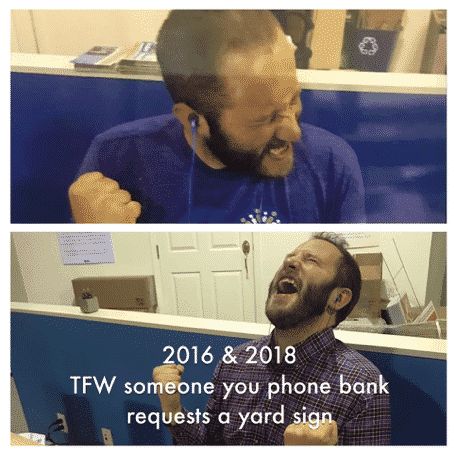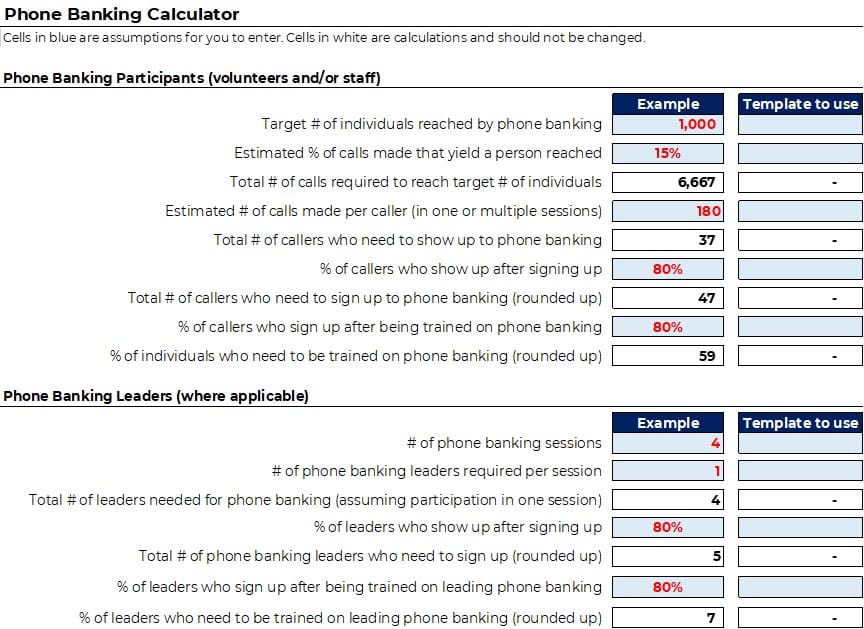PHONE BANKING
Phone banking involves using phone calls to inform and organize community members to take an action.
Downloadable measurement templates
Below are templates of common measures organizations use in the parent empowerment space to manage phone banking.
As a reminder, your organization should ‘Goldilocks’ what it measures. You should only capture measures that help your organization make better decisions to increase impact (and are practical to collect).
Phone Banking Measures for Choice to support parents in understanding their school options and navigating the choice process in their community.
Phone Banking Measures for Collective Voice - Issue Campaigns to change policy by influencing the decision-making of those in a position of authority.
Phone Banking Measures for Vote - Electoral Campaigns to change policy by (a) supporting individuals to get elected (or re-elected) to a position of authority in order to make those changes, or (b) through a publicly decided ballot or proposition.

The objectives of phone banking can include informing and organizing individuals to:
- Sign-up for an ongoing relationship with an organization.
- Take actions to directly support their children's education (by working directly with their children or in their engagement with schools).
- Fill out lottery paperwork to expand the number of schools their children have a chance at attending.
- Sign a petition.
- Commit to attending an event, workshop or training.
- Commit to participating in a public action.
- Register to vote (note, this can be done as a 501(c)3 nonprofit as long as it is done in a non-partisan manner).
- Get-out-the-vote (note, this can also be done as a 501(c)3 nonprofit as long as it is done in a non-partisan manner).
- Vote for a specific candidate or initiative on a ballot, or advocate for a specific piece of legislation (note, this action can only be done through the work of a 501(c)4 nonprofit and not a 501(c)3).
- Take action to support a candidate (such as requesting signage or volunteering).
- Give money (if it is to a nonprofit, this can be done through 501(c)3 work; for a candidate or initiative on a ballot, this requires working as a 501(c)4).
If your organization is considering ANY 501(c)4 political activity, you should first consult knowledgeable legal counsel for formal guidance on your plan of actions, legal structure, financial reporting, etc.
When is phone banking effective?
There is an active debate among practitioners about when an organization should commit its scarce resources of time, talent and money to phone banking vs. canvassing (for more on canvassing, click here).
Phone banking is very effective in helping parents exercise the power of their choice. As Mina Kumar, Chief Program Officer at Families Empowered, observes, “We find that phone or live events are the most effective (also of course the most expensive) means of communicating with parents on something as personal as choosing a school for their child. When you think about it, choosing a school represents an intensely personal decision for a family and reflects their aspirations for their child. These are not decisions parents can easily make based on a visit to a website or an email – our outreach to them and work with them is crucial to supporting them in their decision."

Phone banking has more mixed utility in collective voice (issue) campaigns and vote (electoral) campaigns.
Emerging evidence suggests that canvassing can be more effective (in terms of use of resources) in reaching and engaging with people, and helping them take action.
HOWEVER, this doesn’t mean that phone banking is ineffective. It just may not be as effective.
Parent empowerment leaders also report phone banking is particularly useful when you are trying to reach a lot of people quickly to ask them to take a quick communication action and where the outreach is specifically from community members to other community members they have relationships with. Seth Litt, Executive Director of Parent Revolution, reports that, “we have effectively used phone banks for families to communicate to school board members ahead of a crucial vote and urge a yes vote. Second, we have used phone banks to activate our membership list for referrals for new members. In both of these cases, families called other families in our network with a clear action. These actions had high rates of success since we were calling live contacts that we had some personal relationship with. Families were also largely calling their peers.”
Further, phone banking can still be more practical and effective than canvassing in the following circumstances:
- Seasonal weather that prohibits extensive walking outside.
- Large geographic dispersion between homes, making canvassing impractical. Or conversely, a targeted population in large apartment buildings that aren’t necessarily accessible by canvassing.
- Volunteers who want to help but because of accessibility cannot walk long distances.
Jack Holtzman, Director of Policy and Data at GO Public Schools counsels in regards to issue and electoral campaigns, “We always try to steer people toward canvassing, if possible. We think it's a more effective use of folks’ time and, frankly, a more enjoyable one. That said, there are always sections of turf that we need to phone bank because a) the turf is hilly and walking isn't efficient or b) the turf is mostly made up of apartment buildings that we can't access. We also add to the phone banking list throughout the campaign as we find individual homes that are inaccessible for some reason or another. We try to fill those phone banking slots with people who can't canvass for either timing or physical reasons, or who just prefer it.”
For electoral campaigns, phone banking (and also canvassing) can be particularly effective in reaching out to people in the last five days of an election to focus on voter turnout of already supportive voters. Researchers have found that reaching out to people who have previously committed to vote increased voter turnout by 12%.
Keys to effective phone banking
- Phone banking is not just about the number of people who are reached. It is about targeting the RIGHT people to reach in a campaign. Finding and targeting individuals who have the ability to exercise power in support of your campaign is crucial for both effectiveness (reaching the right members of a community) and efficiency (not spending scarce resources of time, talent and money in conversation with people who are unlikely or unable to support your campaign).
- Phone banking is also about the quality of your engagement with the people you reach. People respond to what and who they can relate to. Engaging people in phone banking is therefore about how to quickly build a relationship with someone and create connections between what matters to them and the campaign agenda that matters to you. A caveat: Phone banking also requires succinct conversations in order to effectively reach the target number of individuals.
- Quality engagement means investing in training and tools. Phone banking is asking a lot of people – calling total strangers can be challenging! Organizations can make it easier by doing the following to support its callers:
- Be crystal clear on the specific ask(s) being made during phone banking.
- Provide a script that allows callers to quickly connect with the people they are speaking to and allows them to know how to respond to various questions and comments people are likely to have.
- Ground that script in tested messaging, where possible using polling, focus groups, or even A/B testing (trying different options with different audiences where there is a large volume of people being contacted) to understanding what messaging is most effective. One practitioner also notes that, “feedback helps to edit your script by removing phrases that kill a conversation.”
“Phone banking (and canvassing) is an exercise in sharing the ‘why’ for volunteers. Why do they feel urgency about the fairness of the education system? Why do they need other people to act on behalf of children? Why are they volunteering? Inside, we all know our ‘why’ when we show up to volunteer at something. Talking to a stranger challenges us to express our values in a way that is clear and that motivates the other people to action. Once we know how to do that, when we’ve found our words and our story on our issue, we can be effective leaders and advocates.”
— Seth Litt
Executive Director
Parent Revolution- Provide training and coaching to callers increases their ability to execute and demonstrates your commitment to them. In the beginning, practice ‘I do, we do, you do’ to help ease callers into this work and help them understand what is effective.
- Provide some flexibility to allow callers to own their messaging so they can make it personal. One leader shared that within their script, there are options on talking points so that callers can, “select the message that most resonates with them so their enthusiasm will translate to the person they are speaking with.”
Seth Litt, Executive Director of Parent Revolution, counsels, “Phone banking is an exercise in sharing the “why” for volunteers. Why do they feel urgency about the fairness of the education system? Why do they need other people to act on behalf of children? Why are they volunteering? Inside, we all know our ‘why’ when we show up to volunteer at something. Talking to a stranger challenges us to express our values in a way that is clear and that motivates the other people to action. Once we know how to do that, when we’ve found our words and our story on our issue, we can be effective leaders and advocates.”
- Plan for and manage expectations on conversion rates of calls to conversations. Plan your phone banking action based on a realistic number of calls per hour per caller, how many of those calls will result in a person picking up, and how many of those people will be willing to have a conversation. This is important not only for managing this action for your organization, but also in managing the expectations of your callers about how hard this work is and what success looks like.
Results for issue and electoral campaigns can range from 20-50 calls per person per hour, with 5-8 of those resulting in a conversation. Please note, these numbers vary based on: (a) the quality of the phone list (is it the list of your organization’s active members who are more likely to respond and engage, or a voter file of general community members?); (b) calling cell-phones (higher hit rate but slower to dial) vs. landlines; (c) time of day; (d) if you are using an auto-dialing service (faster) vs. manual dialing (slower); and (e) the nature of your ask.
Results for choice campaigns are closer to 10-15 conversations per hour, in part because they are calling individuals interested in better understanding and navigating their school options.
- Make phone-banking easy and (where possible) fun so people do well, like the work, and return. Phone banking is work. Cold-calling and talking to people who may disagree with you (or hang up on you) is hard. Provide refreshments and a comfortable environment for calling. Make it friendly competition between callers with leaderboards and ways of acknowledging success. This also helps you identify who is really good at phone banking and could be a good trainer/leader of phone banking actions for your current or future campaigns.
“Your best asset is a returning volunteer,” observes one leader. “They don’t need to be trained so they can jump right in, and the more you phone bank or canvass the better you get. Anything you can do to make the experience fun, make people feel appreciated, and make people feel that they are doing something that matters will greatly improve your outcomes over time.”
- Not everyone who signs up for phone banking shows up, so plan accordingly for what is known as the “flake-factor.” An organization can counteract the flake-factor by: (a) building strong relationships with parents and ensuring parent leaders have strong relationships with other parents; (b) being diligent in your follow up to remind people; (c) making phone banking feel like a group effort that builds collective responsibility to one another; and (d) reducing barriers to participation (e.g., matching a person to the day of week and/or time of day that they are available).
- The time of day and day of week when phone banking occurs matters. Know when the people in the community you are trying to reach are likely to be home.
- Technology can enable more efficient, effective phone banking and provides crucial back-end information and analytics. Applications and platforms have emerged that help organize and optimize phone banking and integrate phone banking data with other data about individuals, including their demographics, voting habits, and existing relationship with your organization.
- Tracking unique identifiers (using technology) for individuals enables your organization to measure in after-action analysis whether and where phone banking was effective in reaching the right individuals and if it resulted in them taking action – particularly voting.
- Debrief for constant learning. After a phone banking session, debrief with callers to help them process their experience, and identify and share strong practices around messaging and approach that will make future phone banking efforts more effective.
- Always thank people for participating in phone banking.
Particularly for electoral campaigns:
- Electoral work promoting a candidate or advocating for a specific piece of legislation must be done under the auspices of a 501(c)4 nonprofit, not through a 501(c)3 nonprofit (though voter registration and generic get-out-the-vote CAN be done by a 501(c)3).
- When phone banking occurs in an election cycle matters: Research indicates that individuals are less persuadable the closer you get to an election date.
- Phone banking is effective in catalyzing action by voters who agree with your candidate or issue but are unlikely to actually turnout and vote. Researchers have found that reaching out to people who have previously committed to vote increased voter turnout by 12%.
The math of phone banking
Each organization should set phone banking targets based on a range of variables such as local context, its impact agenda, mapping local power, the organization’s infrastructure, etc. (refer to the section on target-setting for more detail).
There are some fundamentals to quantifying a phone banking action included in the downloadable phone banking calculator below.

225 Franklin Street, Suite 350
Boston, MA 02110
617.912.8800
This work is licensed under a Creative Commons Attribution-NonCommercial-ShareAlike 2.0 License (CC BY-NC-SA 2.0)
Click Here to learn more.

